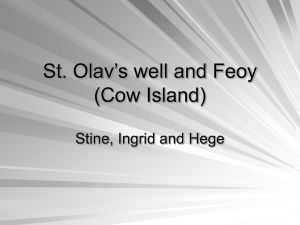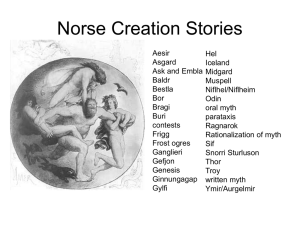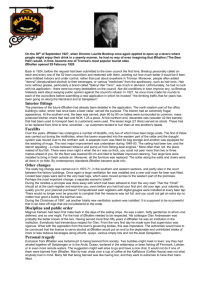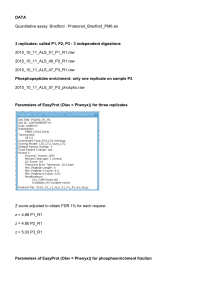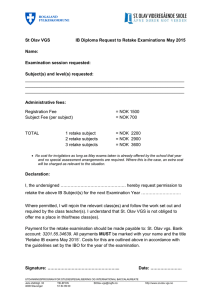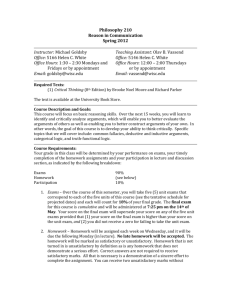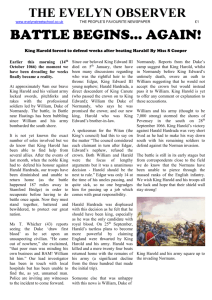The Past in Snorri Sturluson's Heimskringla
advertisement
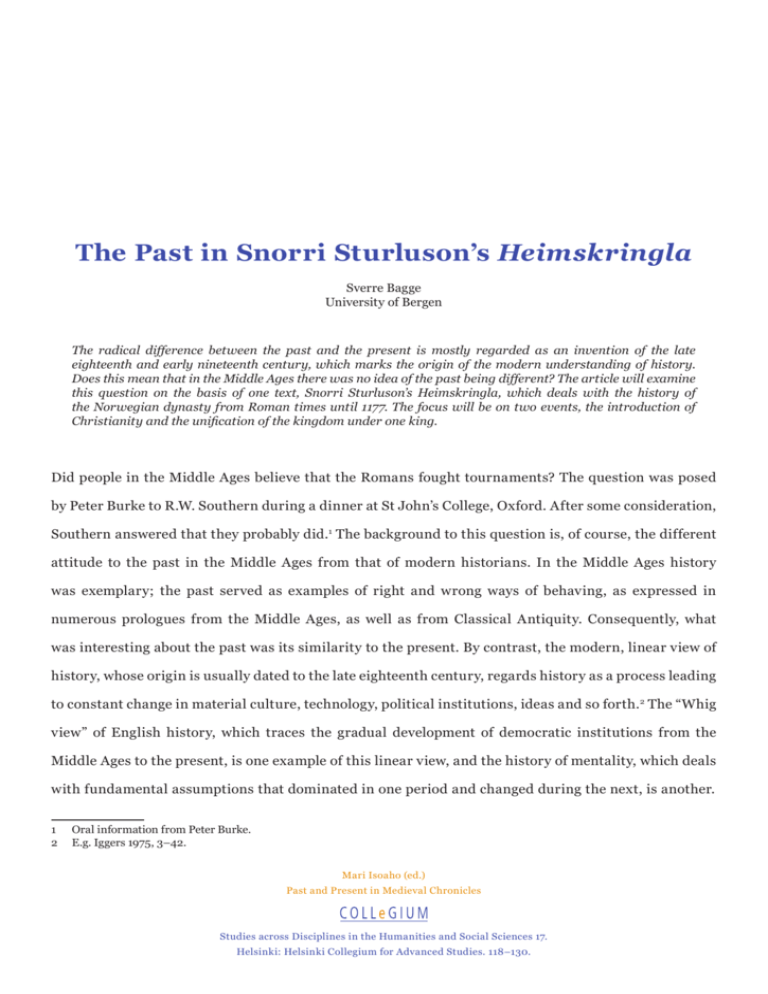
The Past in Snorri Sturluson’s Heimskringla Sverre Bagge University of Bergen The radical difference between the past and the present is mostly regarded as an invention of the late eighteenth and early nineteenth century, which marks the origin of the modern understanding of history. Does this mean that in the Middle Ages there was no idea of the past being different? The article will examine this question on the basis of one text, Snorri Sturluson’s Heimskringla, which deals with the history of the Norwegian dynasty from Roman times until 1177. The focus will be on two events, the introduction of Christianity and the unification of the kingdom under one king. Did people in the Middle Ages believe that the Romans fought tournaments? The question was posed by Peter Burke to R.W. Southern during a dinner at St John’s College, Oxford. After some consideration, Southern answered that they probably did.1 The background to this question is, of course, the different attitude to the past in the Middle Ages from that of modern historians. In the Middle Ages history was exemplary; the past served as examples of right and wrong ways of behaving, as expressed in numerous prologues from the Middle Ages, as well as from Classical Antiquity. Consequently, what was interesting about the past was its similarity to the present. By contrast, the modern, linear view of history, whose origin is usually dated to the late eighteenth century, regards history as a process leading to constant change in material culture, technology, political institutions, ideas and so forth. 2 The “Whig view” of English history, which traces the gradual development of democratic institutions from the Middle Ages to the present, is one example of this linear view, and the history of mentality, which deals with fundamental assumptions that dominated in one period and changed during the next, is another. 1 Oral information from Peter Burke. 2 E.g. Iggers 1975, 3–42. Mari Isoaho (ed.) Past and Present in Medieval Chronicles Studies across Disciplines in the Humanities and Social Sciences 17. Helsinki: Helsinki Collegium for Advanced Studies. 118–130. Sverre Bagge Nevertheless, the medieval view did not imply that the past was exactly similar to the present. Medieval chroniclers, of course, knew that the ancient Romans had a different religion and to some extent different political institutions. Roman ruins, spread over large parts of Europe, showed buildings different from contemporary ones. When Otto of Freising has Frederick Barbarossa state that the Roman political institutions, the senate, the knights and the camp were now in Germany, he does not necessarily imply that the contemporary political institutions were exactly like those of the Romans, but rather that the essential features of Roman virtues had now been transferred to Germany.3 Thus, it does not follow from the general medieval view of the past that people of that period believed that the Romans fought tournaments. It would seem likely that most of them did, but it was clearly possible for learned men with a sound knowledge of Roman history to see that this was not the case. Moreover, a possible exception to the static view of the past in the Middle Ages is the Christian idea of periodization. History has a beginning – the Creation – and an end – the Second Coming, while Christ’s First Coming represents a radical change in the relationship between God and humanity. In accordance with this, Christianity introduced several kinds of periodization based on the Bible. History was divided into seven epochs, corresponding to the seven days of Creation or into four empires, corresponding to the prophecy in the Book of Daniel. The difference between these epochs is open to discussion, but R.W. Southern himself has pointed to a kind of evolutionary understanding of history in the twelfth-century writings of Hugh of St Victor. 4 It has also been suggested that this understanding of history is an important source for the new, linear idea of historical development that arose in the eighteenth century. Nevertheless, its practical importance for the writing of history during the period should not be exaggerated. As most of the history dealt with by medieval chroniclers took place in the sixth and, in practice, the last epoch, the period from the birth of Christ to the Day of Judgement – the seventh day was eternity – this division gave little aid to the structuring of the narratives. The Origins of the Norwegian Dynasty in Heimskringla The main subject of the present article, Snorri Sturluson’s Heimskringla, was written in the vernacular, not by a learned theologian but by a secular aristocrat. Snorri Sturluson (1179–1241) was one of the most prominent chieftains in Iceland and an active participant in the internal struggles on the island. He had close contacts in Norway, notably with Skule Bårdsson, the rival of King Håkon Håkonsson, 3 Bagge 1996: 357–59. 4 Southern 1971. 119 Past and Present in Medieval Chronicles and was eventually killed as a result of a conflict with King Håkon. Snorri is one of the last in a series of writers in the late twelfth and early thirteenth centuries dealing with earlier Norwegian history. He knew and used most of the works of his predecessors, the most important of which are Morkinskinna (ca 1220) and Fagrskinna (ca 1220), which respectively cover the periods 1030–1157 and ca 800–1177. In addition, he made extensive use of the biographies of the two missionary kings, Olav Tryggvason and St Olav Haraldsson, the former by Odd Snorrason Munk (ca 1190), the latter in the so-called Oldest Saga and Legendary Saga (ca 1200) by one or more anonymous authors.5 Snorri’s work, called Heimskringla after its opening words, was probably composed around 1230 and deals with the history of the Norwegian kings from the origin of the dynasty until 1177. It is thus the history of the dynasty, not the kingdom of Norway. In contrast to normal practice in Latin historiography – such as the twelfth-century Historia Norwegie – there is neither a geographical introduction with a presentation of the country nor a systematic account of the chieftains and principalities at the time of the foundation of the kingdom. Instead, Snorri devotes the first saga of Heimskringla, Ynglinga saga,6 to tracing the origins of the dynasty to Inner Asia, where the god Odin, whom Snorri regards as a human being and a great king, started his conquests at the time the Romans conquered the Mediterranean. Snorri then lists a total of twenty-eight kings from Odin to Harald Finehair, the founder of the kingdom of Norway. According to Snorri, the majority of these kings ruled in Sweden and had no connection with Norway. Only number twenty-four in the line, Halvdan Whiteleg, moved to Norway, after his father, Olav the Woodcutter, had been killed by the Swedes. Halvdan became king of Romerike and Vestfold in eastern Norway and was buried in Skiringssal in Vestfold. His son Øystein was the great-grandfather of Halvdan the Black, Harald Finehair’s father, whose reign can be dated to around the middle of the ninth century. Ynglinga Saga is relatively brief and gives few details about the individual kings. Its purpose largely seems to be to place the history of the Norwegian kings in wider perspective. If we apply the usual reckoning in generations of thirty years, the combined reigns of the twenty-eight kings amount to 840 years altogether, which dates the beginning of the dynasty to around the time of the birth of Christ. Snorri adds that the founder of the dynasty, the pagan god Odin, whom he regards as a king who was worshipped as a god after his death, lived at the time the Romans conquered the Mediterranean. Odin understood that his own future would have to be in another region and therefore founded his kingdom 5 Andersson 1985. 6 Jónsson 1893–1901, vol. 1, 9–85. 120 Sverre Bagge in the north. Thus, Snorri manages to situate the history of the Norwegian dynasty in a larger global context and also connect it to the history of salvation. The next turning point in Heimskringla is the reign of Harald Finehair. Finehair’s father, Halvdan the Black, is given a brief history, which sketches the background of Harald’s later conquests and contains two dreams prophesying Harald’s conquest of the country. Turning to Harald, Snorri follows his predecessors in regarding him as the founder of the contemporary kingdom, but he is unique in giving a detailed account of how and why Harald carried out his conquest. His predecessors confine themselves to stating that Harald conquered the country; some of them also quote some stanzas of the skaldic poem of Harald’s last battle, that of Hafrsfjord, just south of present-day Stavanger. Snorri gives the following explanation of Harald’s decision to conquer the whole of Norway. Having heard about a beautiful woman, Gyda, daughter of the king of Hordaland in western Norway, Harald sends for her, asking her to become his mistress. Gyda haughtily refuses, on the grounds that she will not waste her virginity on a petty king who rules over only a few counties. She adds that she finds it strange that no king has attempted to rule the whole country. The messengers report Gyda’s answer to Harald, expecting him to become furious and send an army to punish her. However, Harald expresses his gratitude to this woman who has reminded him of what he ought to have thought of himself, swearing by Almighty God never to cut his hair or his beard until he has conquered the whole of Norway.7 The story is not known from any other source and may well have been Snorri’s own invention. It is also very far from the strategic considerations that are normally attributed to great conquerors. It does, however, serve to underline the extraordinary character of Harald’s achievement and thus points to the conquest as a turning point in Norwegian history. It is not an extension of ongoing struggles, but rather a plan conceived by one individual, which causes the history of the country to follow a completely new course. Before Harald, there was a series of petty kingdoms whose existence was more or less taken for granted. Although there was a concept of Norway as a country, it had not occurred to anyone that this country could form a political unit. It took a haughty woman to conceive of the idea and a great man like Harald to make it a reality. Harald’s oath on this occasion is also significant, for despite being a pagan, Harald appeals to Almighty God. Thus, there is a connection in kind as well as in intrinsic importance between the unification of the kingdom and its Christianisation.8 Halvdan’s dream, with the prophecy about Olav, may also be regarded as evidence of this. 7 Jónsson 1893–1901, vol. 1, 101–03. 8 A similar idea is expressed in an addition to Fagrskinna (Jónsson 1902, 386–87), where in a speech Harald refuses to participate in the pagan sacrifices, pointing to the parallel between God’s rule of the world and his own of Norway. 121 Past and Present in Medieval Chronicles Harald Finehair’s Founding of the Kingdom of Norway In the next part of his narrative Snorri describes a series of struggles and alliances, but in a different way from before. No longer are individual acts of violence followed by reactions or revenge, but rather a systematic war of conquest takes place.9 Harald proceeds in accordance with the main features of the geography of Norway. He leads his army northwards towards Trøndelag, defeating various rulers on his way. In the north he concludes an alliance with the ruler of Trøndelag, the Earl of Lade, and then moves south along the coast, conquering parts of western Norway. After an interlude in the east, where he fights the king of Sweden, Harald crushes the last resistance against him in the Battle of Hafrsfjord, south of present-day Stavanger. Then he sends for Gyda and makes her his mistress, with whom he has several children.10 Whatever the details of the conquest, Snorri is in no doubt that it was a landmark in the history of Norway. This is expressed particularly clearly in his account of Harald’s administrative system. He takes hold of all property (óðall) in the country, making all its owners his tenants. He appoints one earl ( jarl) in each county (Old Norse fylki) and four officials of lower rank (hersir) under each earl, and he fixes the salaries of these officials, as well as their duties and the number of men they have to muster for the king’s service.11 The idea of the king as the owner of the country is probably derived from thirteenth-century ideas about the foundation of royal power.12 The rest of the administrative system is likely to have been Snorri’s construction, although possibly based on a few examples he may have known. Snorri never gives a complete description of the system in practice at any later stage and even contradicts his own account by citing a rule, allegedly introduced by St Olav and his successor Harald Hardrada, that there should be only one earl in the country at one time.13 However, later in his narrative he occasionally refers to the arrangement he attributes to Harald Finehair when discussing local divisions of power. Although Snorri rarely mentions hersir, he does provide detailed information about Harald’s appointment of earls. Harald’s closest friends and allies, such as Håkon and Sigurd of Lade and Ragnvald Mørejarl, are described as being appointed as earls of more than one county; thus, in practice, the bureaucratic structure Snorri attributes to Harald is modified considerably. 9 Jónsson 1893–1901, vol.1, 103–26. 10 Snorri does not refer to Gyda as Harald’s wife, in contrast to some of his other mistresses. It is not clear to what extent he really wants to differentiate between wives and concubines; in any case, Harald is polygamous. 11 Jónsson 1893–1901, 104–05. 12 Bagge 1987, 31–38. 13 Jónsson 1893–1901, vol 3, 142. 122 Sverre Bagge It is evident from the sagas of Harald’s successors that Snorri regards Harald’s unification as final, in the sense that there is now a general consensus that the territory of Norway should form a political unit and that there is a dynasty with a legitimate claim to rule it. Although the following period is far from peaceful, the struggles are all about the control of the country as a whole. The lines of division are as follows: (1) the various descendants of Harald contending against another; (2) the descendants of Harald against the earls of Lade, Håkon Grjotgardsson’s descendants and (3) the kings of Denmark seeking to exploit the internal rivalries in Norway to increase their own power. The main outline of these conflicts is found already in the works of Snorri’s predecessors, but there are also traces of conflicts there that suggest that this relatively neat arrangement was the result of the saga writers’ constructions and that there were still a number of petty kings and chieftains fighting for power.14 The Formation of the Christian Kingdom Harald’s conquest thus represents a radically new step in the history of the dynasty, as well as in the history of the country. The next step occurs when the dynasty achieves a monopoly on ruling the country and eliminated its competitors. This largely coincides with the introduction of Christianity, carried out by the kings Olav Tryggvason (995–1000) and St Olav Haraldsson (1015–30), both, according to Snorri, descendants of Harald Finehair. The first Olav arrives from England and replaces the last pagan ruler, Håkon, Earl of Lade. After a long and successful reign, Håkon becomes unpopular in his old age, because he forces the wives and daughters of the leading men in Trøndelag to have sex with him, which leads to a rebellion. At the same time, Olav Tryggvason arrives in Norway, enticed by Håkon himself, who plans to have Olav killed on his arrival. But Håkon has to flee and is helped by his mistress to hide under a pigsty together with his faithful slave, named Kark, who eventually kills him. The story is mentioned by most of Snorri’s predecessors. However, Snorri adds the following comment: “And that was the main reason why this happened, that the time had come when the blót and its practitioners were to be condemned, and in its place came holy faith and right customs”.15 Snorri’s problem here is the following: why did this clever and highly successful chieftain suffer such a shameful death? Normally, those who are smart and clever are also lucky. Håkon was in this case extremely unlucky. Admittedly, he was partly to blame for his fall; his sexual behaviour was bound to create resentment. The rebellion that followed was thus to be expected, but Håkon was extremely unlucky in that it coincided with the arrival of Olav Tryggvason, whom he could easily have gotten rid of had 14 Krag 1989; Bagge 2006, 495–99. 15 Jónsson 1893–1901, vol. 1, 356. 123 Past and Present in Medieval Chronicles the rebellion not occurred. Even then, Håkon might have escaped had it not been for his slave Kark’s treachery. Kark had apparently been Håkon’s private servant throughout his life – the two were born on the same night; he had been treated well and had always been loyal. He was probably the person in Håkon’s surroundings most likely to be trusted. His treachery seems in Snorri’s account to be the result of a combination of panic and temptation, as he listens to Olav Tryggvason promising a great reward to the person who kills Håkon. Taken together, these factors amount to such extreme bad luck that a supernatural explanation seems likely. Such an explanation easily presents itself when the pagan Håkon is succeeded by the great missionary king Olav Tryggvason, who brings about the conversion of the country. Snorri’s reference to God’s providence in this case serves to explain an extremely unlikely event and thus cannot be taken as evidence of a general explanation of historical events by God’s providence or of a consistent division between the pagan and the Christian period in the whole work. However, it does point to the introduction of Christianity as marking a new epoch, a feature Snorri develops together with his picture of the Christian kings restoring Harald’s unification of the country. Olav begins his reign with an itinerary that parallels Harald’s, although its sequence and purpose are different. Olav travels along the coast from the Oslofjord area to Trøndelag in order to introduce Christianity.16 He begins in the east, where he has relatives and friends who easily accept the new religion, while the difficulties increase as he moves further west and north. In most places he succeeds by offering his friendship and in some cases by marriage alliances, but in Trøndelag and later in northern Norway, he has to use force, destroying pagan cult sites and killing or threatening to kill those who refuse baptism. Snorri’s focus is clearly on the religious change, but it hardly escaped him that the introduction of the new religion implied a royal presence over large parts of the country similar to that of the age of Harald Finehair. Olav Tryggvason’s short reign ends in his defeat and death in the Battle of Svold in the year 1000. Norway is now divided between the victors: the Danish King Svein Forkbeard, the Swedish King Olof Skotkonung and the Norwegian earls of Lade, Eirik and Svein. In practice, the latter two rule most of the country, but on behalf of their Danish and Swedish overlords. Thus, Norway is divided and placed under foreign rule, and Harald Finehair’s descendants have lost their power with the exception of a few, who rule as petty kings in the east. 16 On this topic see Andersson 1977 and Bagge 2006, 506–07. 124 Sverre Bagge This is the situation at the time when the brilliant young pretender, Olav Haraldsson, returns to Norway in 1015. According to Snorri, Olav was also Harald’s descendant one generation removed: Olav Tryggvason was the grandson of Harald’s son Olav Geirstadalv, while Olav Haraldsson was the great grandson of Olav’s brother Bjørn, nicknamed Merchant ( farmaðr). All the sagas, including Heimskringla, underline the later Olav’s link to the dynasty more strongly than that of his namesake.17 In various ways Snorri depicts Olav as Harald’s heir – in the direct sense as the man who descended from him and had the right to his kingdom, as well as in the wider sense as the one who fulfilled the task Harald began. While in England, Olav is commanded by God to return to Norway to become its eternal king. Shortly after Olav’s arrival in Norway, Snorri describes Olav giving a speech to his mother and stepfather, proclaiming himself Harald’s heir and asking them for aid in conquering the kingdom.18 After some discussion they accept him and give the necessary support for him to be acclaimed king at the local assembly of Eastern Norway.19 Later, Olav is also acclaimed in Trøndelag and, after his victory at Nesjar the next year, by all assemblies in the country. Thus, the combination of hereditary right and acclamation by the people is emphasised even more strongly in Olav’s case than in that of his predecessors.20 However, the political considerations that lead to this result are also more strongly emphasised and discussed in great detail. Olav’s legal claim is apparently of no importance in the discussion between the petty kings, who are the first to accept him. The argument in his favour is that he is a winning type, who will be able to reward his supporters and will be most likely to win in any case, so that it would be best to support him at once. The counter-argument is that Olav will be too interfering and that a distant king, the king of Denmark, who at the time held power in Norway, was to be preferred. Olav’s final acclamation over the whole country is depicted as the direct consequence of his victory at Nesjar. Snorri has more to say about Olav’s governing of the country than that of his predecessors. In the beginning of his saga, he presents a whole network of men in various parts of the country.21 In the east Olav has one man on each side of the Oslofjord, one further north around Lake Mjøsa and one even further north in Gudbrandsdalen. Moreover, he has relatives in Ringerike. The network is sparser in the rest of the country. Most important are the Arnasons in the Møre region, one of whom, Kalv, is placed in 17 Bagge 2010, 287–90. The link is expressed particularly strongly in the Legendary Saga of how Olav’s foster father Rane entered the grave of Olav’s ancestor and namesake Olav Geirstadalv – not Harald’s son but his uncle – and brought Olav his sword and ring. See Heinrichs 1989. This story is not included in Heimskringla. 18 Jónsson 1893–1901, vol. 2, 46–50. 19 Jónsson 1893–1901, vol 2, 50–54. 20 Jónsson 1893–1901, vol. 2, 57–58, 88. 21 See Bagge 2002, 184–87. 125 Past and Present in Medieval Chronicles Trøndelag on a farm Olav has confiscated from a man executed for pagan practices. In northern Norway Olav mostly takes over the network of his predecessor, Olav Tryggvason. Most of western Norway is controlled by Erling Skjalgsson, whose power Olav tries to limit. Does Snorri regard Olav’s policy as a novelty or as a continuation of the normal practice of his predecessors? It is clear from Snorri’s account that Olav works through personal friends rather than trying to establish a bureaucratic structure. The few local officials (ármenn) mentioned in his saga hardly represent a novelty and are in any case not intended to replace the normal network of magnates. Snorri does not specify the size of the areas under the control of Olav’s friends or mention whether these areas were smaller than those granted by his predecessors. In any case it is very unlikely that any of them had a territory the size of Erling Skjalgsson’s ‘principality’ in the west. This may indicate that Olav was conducting a different policy from that of his predecessors, notably Olav Tryggvason. On the other hand, there is a difference between granting a large territory to a man appointed and trusted by the king himself and accepting the existence of a similar territory granted by one’s predecessor. Snorri seems to think that Olav should have trusted Erling Skjalgsson and that his attempt to reduce his power only created unnecessary tension, but it is easy to see that an ambitious king might object to a magnate with such extensive territory. The conflict between Olav and Erling continued throughout Olav’s reign and eventually contributed to his exile and death. However, Snorri stresses that Erling did not really want to fight Olav but was more or less forced to do so. When open conflict broke out between Olav and Erling, they had just concluded an agreement. Then Erling’s stupid nephew Asbjørn kills Olav’s local representative in his presence, and Erling is honour bound to intervene on his behalf. Tore Hund, paternal uncle to the same nephew, is under the same obligation and has to avenge Asbjørn who is killed by one of Olav’s men, despite Tore’s wish to keep the king’s friendship. In both cases, Olav exacerbates the conflict because of his stubborn attitude.22 Thus, there is a contrast between Snorri’s explicit statements about Olav and the opinions conveyed in his narrative. In my book Society and Politics in Snorri Sturluson’s Heimskringla I regarded the narrative as the expression of Snorri’s real opinion and the explicit statements as conventional phrases that had to be included out of respect for the saint who was buried in the cathedral of Nidaros and his successors on the Norwegian throne.23 Now I am less certain of this interpretation. To know how Snorri 22 Bagge 1991, 66–70 and Bagge 2010, 305–15. 23 Bagge 1991, 68–70. 126 Sverre Bagge explains political events, his narrative is no doubt a better source than his explicit comments, but I also believe that he was serious about Olav’s sanctity and felt a real admiration for him. He may even have thought that Olav’s political blunders were not normal blunders, but could be explained by his high principles of objective justice. Moreover, Snorri is not the only historian to attribute both positive and negative characteristics to Olav. The tension between the two sides of his character is even greater in the earlier Legendary Saga, which, directly or indirectly, was Snorri’s source, but Snorri achieved greater harmony by reducing the expressions of Olav’s ruthlessness as well as the expressions of his sanctity. 24 In any case, such considerations form an important part of Snorri’s long-term interpretation of Olav’s reign, as not just a phase in the continuous struggles for power between kings and magnates, but as a turning point in the history of the country. When the petty kings in the east – Olav’s alleged relatives – rebel against him soon after they have accepted him as king, Snorri celebrates his victory over them, adding that Olav was now the only man to be named king in Norway.25 Thus, Olav restored Harald’s unification of the country under one king. He also fulfilled the prophecy inherent in Harald’s promise about conquering the whole of Norway by converting the people to the Almighty God to whom the pagan Harald had appealed. After Olav, Norway remained united under one dynasty, albeit one whose members did not always keep peace between themselves. The line of the earls of Lade died out with Håkon the Younger, who ruled for a short time during Olav’s exile. Despite the fact that the Danes seemed to have won a total victory with Olav’s defeat and death at Stiklestad, Olav’s reign was a turning point in this respect as well. The Danish tyranny and Olav’s sainthood united the Norwegians against the Danes; the men who had fought Olav at Stiklestad joined together to oppose their new lords and chased them out of the country. In the following period Olav’s successors, Magnus the Good and Harald Hardrada, fought to conquer Denmark. Snorri deals with this turning point in considerable detail, describing Olav’s miracles, the Danish oppression and the reactions to both. He does not depict a people in sackcloth and ashes in repentance over their killing of a saint, but rather their recognition that Olav was a lesser evil than the Danish rulers. In particular, Olav’s old enemy Einar Tambarskjelve, who now emerges as the strong man, exploits Olav’s sainthood to serve his own interests.26 The Danish king Cnut has failed to keep his promises, and Einar now brings Olav’s son Magnus back to the country in order to gain for himself the position Cnut promised him as the leader of the country. 24 Bagge 2010, 316–18. 25 “Bar þá Óláfr einn konungsnafn í Nóregi”. See Jónsson 1893–1901, vol. 2, 131. 26 Jónsson 1893–1901, vol. 2, 514–15; See Bagge 1991, 214. 127 Past and Present in Medieval Chronicles The change of regime actually proves to be a success. The young Magnus starts out as a strict ruler, seeking revenge on his father’s enemies. After the skald Sigvat rebukes him in a poem, however, he changes and becomes Magnus the Good, 27 in many ways a parallel to Håkon the Good, who reigned one hundred years earlier. Magnus creates peace and unity in the country, respects the people’s rights and keeps Einar as his closest friend and counsellor. He is successful abroad, is elected king of Denmark and wins a great battle against the Slavs (Wends) at Lyrskoghede in Schleswig (1043). Towards the end of his reign, Magnus is forced to share power with his uncle, Olav’s half-brother Harald, who soon afterwards succeeds him (1046–66). Magnus’s reign does not bring an end to the internal conflicts in the country. There is rivalry between him and Harald during their short rule together, and a new series of succession struggles begins in the 1130s and continues during the rest of the period covered by Heimskringla. However, according to Snorri, all conflicts take place among the descendants of Harald Finehair and are directed at controlling the whole of Norway. In this sense Harald’s conquest represents a permanent change. An additional change, to some extent anticipated by Harald, is the introduction of Christianity. Snorri deals extensively with the conversion, particularly in the saga of Olav Tryggvason, and is in no doubt that Christianity represents the victory of the true faith. Nevertheless, he is respectful in his account of the old religion and largely explains the conversion in secular terms, notably as the result of the personal charisma of the Christian kings and the desire to gain their friendship. Society as a whole is largely the same in the pagan and the Christian periods. To some extent this sameness also applies to kingship, where the individual differences between kings of both periods are greater than those between pagan and Christian kings, although it is no coincidence that the final consolidation of the Norwegian monarchy takes place under St Olav, who completes the conversion of the country. In this way Olav carries out the task anticipated in Harald’s appeal to the highest God, who is represented on earth by the king. Conclusion: Snorri’s Understanding of Historical Change Snorri creates a more coherent story of the development of the Norwegian kingdom than his predecessors had done. He gives a far more exact chronology – probably to a great extent his own creation – which in turn he uses to show the causes as well as the consequences of various individual actions. He also presents a more precise institutional framework by showing how Harald organised his new kingdom 27 Jónsson 1893–1901, vol. 3, 30–34. 128 Sverre Bagge and how this organisation was partly taken over and partly modified by his successors. In particular, he depicts St Olav as the one who carries out Harald’s work, partly by gaining full control of the territory Harald had conquered and partly by the final introduction of Christianity, which meant that not only was there just one king for the whole country, but also only one God. Like other historians in the Middle Ages, Snorri mainly deals with individual actors and regards success and failure as the result of greater or lesser skill on the part of his protagonists. Within these limits, however, Snorri creates a more coherent picture of the development of a kingdom than his predecessors or most of his contemporaries in other parts of Europe. There are some European parallels to Snorri’s presentation of national history. William of Malmesbury deals extensively with the Norman Conquest as a disaster as well as an opportunity, God’s punishment for the sins of the Anglo-Saxons as well an improvement of the people’s morals and the integration of the English into the higher European civilisation.28 Otto of Freising deals with the crisis in Germany resulting from the Saxon rebellion and the Investiture Contest and with how the crisis is resolve by its brilliant new emperor, Frederick Barbarossa.29 Both these authors have a more religious emphasis than Snorri, yet both address historical crisis and change from one epoch to another. Did Snorri believe that the Romans fought tournaments? Most likely, he had never reflected on the problem, as there is no evidence of tournaments either in Iceland or in Norway in Snorri’s lifetime. But he was certainly aware of historical change. Snorri knew that Norway had once consisted of petty principalities, that his ancestors had a different religion and different burial customs and, above all, that contemporary conditions were the results of changes over a long period of time. He also tried to explain these changes, partly by secular, partly by religious causes. This does not represent an example of a modern, linear interpretation of history. To Snorri and his contemporaries, history was not primarily about social change; although aware that not everything was the same in the past as in the present, they were more interested in what was similar than what was different. To them, history was exemplary. In addition, Snorri’s account of the unification of Norway may have contained some national appeal, presenting to the king and his court a long line of distinguished ancestors and showing how the Christian kingdom of Norway came into being. 28 Gillingham 2001; Sønnesyn 2012: 193–213. 29 Bagge 1996 and Bagge 2002. 129 Past and Present in Medieval Chronicles References Sources Jónsson, F. (ed.) 1893–1901. Heimskringla. Vols 1–4. Reference Literature Andersson, Th. 1977. The Conversion of Norway according to Oddr Snorrason and Snorri Sturluson. Medieval Scandinavia 10, 83–95. Andersson, Th. 1985. Kings’ Sagas, in Old Norse – Icelandic Literature. A Critical Guide, ed. C. Clover and J. Lindow, Ithaca: Cornell University Press, 19–238. Bagge, S. 1987. The Political Thought of the King’s Mirror. Odense: Odense University Press. Bagge, S. 1991. Society and Politics in Snorri Sturluson’s Heimskringla. Berkeley, CA: The University of California Press. Bagge, S. 1996. Ideas and narrative in Otto of Freising’s Gesta Frederici, Journal of Medieval History 22.4, 1996, 345–77. Bagge, S. 2002. Mellom kildekritikk og historisk antropologi. Olav den hellige, aristokratiet og rikssamlingen. Historisk tidsskrift 81, 173–212 Bagge, S. 2006. The Making of a Missionary King – the Medieval Accounts of Olaf Tryggvason and the Conversion of Norway. Journal of English and Germanic Philology 105, 473–513. Bagge, S. 2010. Warrior, King and Saint: The Medieval Histories about St. Óláfr Haraldsson. Journal of English and Germanic Philology 109.3, 281–321. Gillingham, J. 2001. Civilizing the English? The English Histories of William of Malmesbury and David Hume. Historical Research 74, 17–43. Heinrichs, A. 1989. Der Óláfs Þáttr Geirstadaðálfs. Eine Variantenstudie. Heidelberg: C. Winter. Iggers, G.G. 1975. New Directions in European Historiography. Middletown, CT: Wesleyan Univ. Press. Krag, C. 1989. Norge som odel i Harald Hårfagres ætt. Historisk tidsskrift 68, 288–302. Southern, R.W. 1971. Aspects of the European Tradition of Historical Writing. 2. Hugh of St Victor and the Idea of Historical Development”, Transactions of the Royal Histor­ical Society 21, 159–179. Sønnesyn, S. 2012. William of Malmesbury and the Ethics of History. Woodbridge: The Boydell Press. 130
